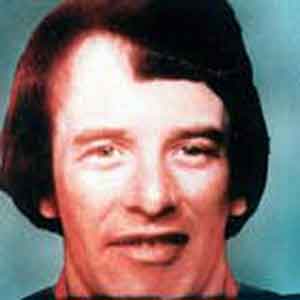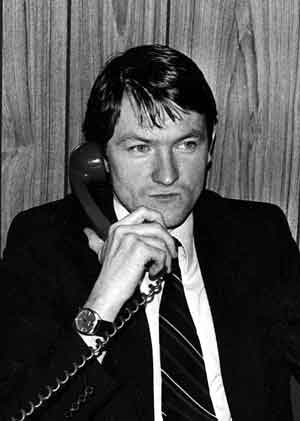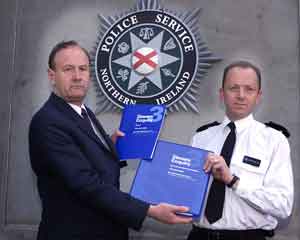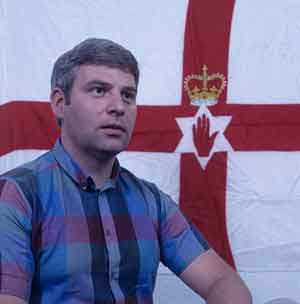BRIAN NELSON—THE RISE AND FALL OF A DOUBLE AGENT
Published in Features, Issue 2 (March/April 2023), Volume 31By Ian S. Wood

Above: Brian Nelson—simultaneously operated as the UDA’s West Belfast intelligence officer and as an agent of the British Army’s secretive Force Research Unit (FRU).
On 5 February 1992 five Catholics, one of them a boy aged fifteen, were murdered in Sean Graham’s betting shop on Belfast’s Lower Ormeau Road. The killers were gunmen from the Ulster Defence Association (UDA). Twenty years on from its formation it was still legal, though not for much longer, and those who killed on its behalf normally used the nom de guerre Ulster Freedom Fighters (UFF).
NELSON AND THE STEVENS ENQUIRY
The day after this atrocity, the trial finished in Belfast of one of the UDA’s most important members, Brian Nelson. Thanks to the 1990 report by Sir John Stevens, then deputy chief constable of Cambridgeshire Police, into alleged collusion with the UDA by elements within British security forces, Nelson, one of 60 loyalists arrested after the report came out, was found to have been working as a senior intelligence officer for the UDA while also feeding them with information from the British Army’s Force Research Unit (FRU). This was a small and secretive body unknown to most of the army, though it reported to the general officer commanding (GOC) troops in Northern Ireland.

Above: Belfast lawyer Pat Finucane. His murder in 1989 was not among the fifteen charges against Nelson at his 1992 trial, despite his being on one of Nelson’s target lists.
Some accounts implicate Nelson in as many as 29 murders, almost all of Catholics uninvolved in the IRA. At his trial, which raised as many questions as it answered, the original fifteen charges against him were dropped. None included the 1989 murder of the Belfast lawyer Pat Finucane, whose name figured on one of Nelson’s target lists.
In the end Nelson admitted to five charges of conspiracy to murder, one of illegally possessing a firearm and fourteen of having information likely to be useful to terrorists. For these he was given concurrent ten-year sentences. The leniency of this sentence, of which he only served half before being spirited safely out of Northern Ireland under an altered name, owed much to a glowing tribute paid to him by the FRU’s then commanding officer who made the unsubstantiated claim that Nelson had saved Catholic lives by aborting some UDA/UFF attacks.
NELSON’S MEMOIR
He also drew upon a lengthy memoir of Nelson’s time as a double agent that he had compiled while awaiting trial. One or two copies of this can still be accessed and in 2015 the Sunday World’s then Northern Editor, Jim McDowell, did an excellent three-part serialisation of this macabre document.
It runs to 120 pages in Nelson’s minuscule but neat and legible hand. There is nothing in it about his early life in the Shankill area or his discharge from the army after just one year. Neither does he allude to his involvement in the UDA’s early years or to the prison sentence he served for his part in the abduction, brutal beating and torture of a Catholic. This appears to have been no impediment to his later return to an active role in the organisation. He quickly became an asset to it with his acquisition of computing skills. These were not common at the time, certainly not for someone like Nelson, who had been a drifter in the job market. He worked intermittently as a house-fitter and carpet-layer, sometimes in Germany, where he had job contacts.
By 1980 he was helping the UDA’s West Belfast brigade to organise its intelligence files on likely targets within the nationalist community. Speaking to BBC’s Panorama in 1992, his sister recalled the quantity of material that he had in his home, stuffed into carrier bags and boxes while he converted it to a database for the brigade and the UDA’s inner council. They valued his work enough to make him their West Belfast intelligence officer in 1985.
MOTIVES FOR WORKING FOR THE FRU?
By then, however, Nelson was also working for the army, sharing all his intelligence with the FRU. Why he did this has been disputed. It has been claimed that he formed a grudge against the UDA for its failure to put pressure on the Ulster Volunteer Force to discipline a member who tried to rape his wife after a drunken party in North Belfast. Money came into it, too. Nelson, whose earnings could vary, was well paid by the FRU, who also provided him with cars and a safe house from which to operate. His prison manuscript records banal disputes over the quality of vehicle he was getting but it also makes for chilling reading, as he documents the day-to-day business of target selection and surveillance. This involved hazardous forays into republican West Belfast, checking out venues where leaders like Gerry Adams might be located.
Adams survived an attempt on his life by the UDA’s Southeast Antrim brigade in Belfast in 1984, and in 1987 Nelson co-ordinated two further attempts to kill him. The first involved the use of a sniper close to the office of the Housing Executive near the city centre. A loyalist ‘mole’ tipped off Nelson about Adams’s likely presence at a meeting there, but on the day the target didn’t arrive. The second plot was to have a magnetic bomb fitted to his car. Again, Adams escaped owing to a strong security presence close to the scene of the planned attack, forcing it to be abandoned. However, Nelson’s army handlers were concerned, he writes, that going for such a high-profile target might compromise his security as a priceless asset to them. Later he also recalls one handler saying that higher up the chain of command there were doubts about Adams being ‘taken out’. This was because his death might hand power to Martin McGuiness, then seen as a militarist with less interest than Adams in finding a political road for republicanism.
DEALINGS WITH JOHN McMICHAEL

Above: Sir John Stevens presenting his third report into allegations of collusion with loyalist paramilitaries by elements of British security forces to PSNI Chief Constable Sir Hugh Orde in April 2003. Thanks to his first report in 1990, Nelson was among 60 loyalists subsequently arrested.
Nelson’s regular briefings of the UDA’s inner council before reporting to the FRU introduced him to John McMichael, second in command to Andy Tyrie. McMichael was intelligent and articulate and saw the need for working-class loyalism to find a political voice. He was also a ruthless co-ordinator of many of the UFF’s attacks, but he had dangerous enemies within the UDA. One of them was Jim Craig, a much-feared thug and extortionist whose ‘loyalism’ didn’t stop him having, partly through his Catholic wife, lucrative financial contacts in republican areas of Belfast.
McMichael wanted Craig placed under surveillance and Nelson organised this, but it was too late to save McMichael, who was killed by an IRA car bomb at his home in Lisburn in December 1987. Some suspected Craig of being implicated but the file on him compiled by Nelson sealed his fate and he was shot dead a year later in a pub in East Belfast by the UFF.
Nelson reveals in his memoir that prior to McMichael’s death he had talked to him about a UDA/UFF bombing offensive across the border. Loyalists had done this before, of course, but the man to whom Nelson refers as ‘the boss’ in the FRU, also at one debriefing put to Nelson the merits of hitting targets in the Irish state in order to put pressure on its policy on cross-border extradition for trial of IRA suspects. Nelson says that he told him that the UDA had the resources to do this, and his FRU ‘boss’ agreed to leave the matter to him and McMichael. They agreed that a prime target, though a difficult one, was the oil terminal on Whiddy Island in Bantry Bay, where an accidental fire in 1979 had killed 50 people. McMichael told Nelson that he had ‘the right people’ with access to the powerful explosives needed. The plan was aborted owing to McMichael’s death but not before the target had been carefully assessed and photographed, with the results passed on to Nelson and his handlers. The possible loss of life does not figure in Nelson’s account.
Nelson’s biggest assignment came in 1985, when he was tasked by the inner council with setting up an arms purchase in South Africa worth £100,000. He duly reported this to the FRU, who passed it up the command structure. A few days later, one of his handlers, referred to as ‘Mick’, is quoted by Nelson as saying, ‘God. You’ve really hit the big time, Brian’. He went on, according to Nelson, to say that the matter had ‘gone all the way to Maggie’, i.e. Prime Minister Margaret Thatcher. Nelson says that he was unconvinced of this and there is as yet no proof that it did. Nelson went out to South Africa to set up the deal, but it came to nothing because only the UDA’s West Belfast brigade was willing to pay for its share of the purchase.
PAT FINUCANE MURDER
Nelson’s deadly double role cost people their lives, possibly 29 in total, but did little real harm to the IRA, whose leaders by this time were a protected species in the eyes of Britain’s undercover services. The most prominent murder set up was that of Belfast lawyer Pat Finucane. In his book Voices from the grave, Ed Moloney described him as ‘the go-to solicitor for the IRA’s Belfast Brigade’. Finucane had important IRA contacts but no operational role. His brutal death has become central to a republican narrative about alleged collusion between loyalists and elements within the security forces. This has crowded off the stage the equally brutal murders of other lawyers such as Edgar Graham, shot dead by the IRA in December 1983.
The real victims in this squalid story were ordinary Catholics, whom the IRA never had much success in defending. Nelson, while he admitted to personal dislike for some UDA men with whom he had to work, showed little pity for their victims. On 10 May 1988 Terence McDaid, a young Catholic bricklayer with no paramilitary connections, was shot dead by the UDA/UFF in front of his family in their home off Belfast’s Antrim Road. Nelson had given the killers details and a photograph of the victim’s brother, Declan, who looked very like him and was an active republican. It is now known, thanks to the diligent work of the Belfast-based journalist Hugh Jordan, that Nelson got the photo from two serving soldiers. One was a female member of the Ulster Defence Regiment and the other was a corporal in the Royal Scots. Both were later given suspended prison sentences by Belfast Crown Court. The female soldier was dismissed from the army, but the corporal was allowed to remain and was later given commissioned rank, finishing his career as a major. Nelson was alarmed by this error and recalls being reprimanded by the FRU. His response was to say that his remit was limited to intelligence rather than actual ‘operations’. The McDaid photo that he had provided was one of many in photomontages that he gave to the UDA to maintain his own cover. When these began to appear publicly in 1990, they were instrumental in Nelson’s arrest by the RUC.
END OF THE ROAD?

Above: The UDA’s second in command, John McMichael—killed by an IRA car bomb in December 1987. In his memoir Nelson claimed that prior to his death McMichael had been planning an attack on the oil terminal on Whiddy Island in Bantry Bay.
This was the end of the road for Nelson, who, after serving half his sentence, died in 2003 far away from Belfast. Very possibly his life was shortened by his chain smoking and heavy drinking. The latter had become a matter of concern to his army handlers. His name, however, has lived on in the continuing debate about collusion and its impact on the conflict. Some participants in this debate were slow to accept that the FRU was also running agents high within the ranks of the IRA, like Freddie Scappaticci, code-named ‘Stakeknife’, who was finally ‘outed’ by a Scottish Sunday newspaper in the year of Nelson’s death. Others claim too much for what collusion achieved. They don’t, for example, answer the question of why, if there was a co-ordinated and over-arching state structure of collusion, it was the police force, the RUC, which in 1990 arrested the army’s principal agent within loyalism. Neither do they answer the question of why collusion, if it was as rife as they claim, didn’t wipe out the IRA. In 2005 Henry McDonald dared to pose the question in a book review, which he titled ‘Where are all the dead Provos?’. Large claims for the results of alleged collusion are a necessary part of a republican version of the Troubles. After all, if you lose a war of your own making, it’s not too hard to open a new front over how its history should be written. As Professor Peter Shirlow has put it in his book The end of Ulster loyalism?, for republicans ‘collusion is an exact science within a discursive and ideologically constructed battlefield in which state wrongdoing is incontestable’.
This is also a narrative innately dismissive of loyalism’s capacity for any autonomous action of its own. Bill Rolston, a scholar of republican sympathies, has denied that the UDA and UVF could ever simply be understood as state-run counter-gangs, but he accepts that collusion did exist as part of what Martin Dillion has called ‘the dirty war’, which drew in people with a messy mixture of motives. For some, like Brian Nelson, the lure of it was not just money but also the dark excitement on offer. Perhaps he can have the last word here on the adrenalin rush of being ‘enmeshed in a web of intrigue, conspiracies, confidences, danger and the power in being aware of things that others around you are not’.
Ian S. Wood is the author of Crimes of loyalty: a history of the UDA (2005) and co-author with Andrew Sanders of Times of troubles: Britain’s war in Northern Ireland (2012), both published by Edinburgh University Press.
Further reading
H. McDonald & J. Cusack, UDA: inside the heart of loyalist terror (Dublin, 2004).
J. O’Brien, Killing Finucane: murder in defence of the realm (Dublin, 2005).
P. Shirlow, The end of Ulster loyalism? (Manchester, 2012).
















